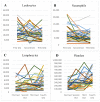Clinical Characteristics and Laboratory Findings in Children with Multisystem Inflammatory Syndrome (MIS-C)-A Retrospective Study of a Tertiary Care Center from Constanta, Romania
- PMID: 36833078
- PMCID: PMC9957378
- DOI: 10.3390/healthcare11040544
Clinical Characteristics and Laboratory Findings in Children with Multisystem Inflammatory Syndrome (MIS-C)-A Retrospective Study of a Tertiary Care Center from Constanta, Romania
Abstract
A new hyper-inflammatory syndrome in children was identified after SARS-CoV-2 infection as a post-infectious complication that is temporally associated with coronavirus disease (COVID-19). Fever, rash, conjunctival hyperemia, and gastrointestinal problems are all clinical manifestations of multisystem inflammatory syndrome in children. This condition, in some cases, causes multisystem involvement, affecting multiple organ systems and necessitating admission to a pediatric intensive care unit. Due to limited clinical studies, it is necessary to analyze the characteristics of the pathology in order to improve the management and long-term follow-up of high-risk patients. The objective of the study was to analyze the clinical and paraclinical characteristics of children diagnosed with MIS-C. The clinical study is a retrospective, observational, descriptive research work that includes patients diagnosed with MIS-C, temporally associated with coronavirus disease, and it contains clinical characteristics, laboratory data, and demographic information. The majority of patients had normal or slightly increased leukocyte counts, which were associated with neutrophilia, lymphocytopenia, and significantly elevated inflammatory markers, including high levels of C-reactive protein, fibrinogen, the erythrocyte sedimentation rate, serum ferritin, and IL 6 and elevated levels of the cardiac enzymes NT-proBNP and D-dimers, owing to the cardiovascular system involvement in the pro-inflammatory process. At the same time, renal system involvement led to raised creatinine and high proteinuria in association with hypoalbuminemia. This characteristic of the pro-inflammatory status as well as multisystem impairment are highly suggestive of the post-infection immunological reaction of the multisystem syndrome temporally associated with SARS-CoV-2 infection.
Keywords: COVID-19 infection; hyperinflammation; multisystem inflammatory syndrome.
Conflict of interest statement
The authors declare no conflict of interest.
Figures







References
-
- World Health Organization . WHO; Geneva, Switzerland: 2020. [(accessed on 1 March 2022)]. Multisystem Inflammatory Syndrome in Children and Adolescents Temporally Related to COVID-19. Scientific Brief, 15 May 2020. Available online: https://www.who.int/newsroom/commentaries/detail/multisystem-inflammator....
-
- Gruber C.N., Patel R.S., Trachtman R., Lepow L., Amanat F., Krammer F., Wilson K.M., Onel K., Geanon D., Tuballes K., et al. Mapping Systemic Inflammation and Antibody Responses in Multisystem Inflammatory Syndrome in Children (MIS-C) Cell. 2020;183:982–995.e14. doi: 10.1016/j.cell.2020.09.034. - DOI - PMC - PubMed
LinkOut - more resources
Full Text Sources
Research Materials
Miscellaneous

